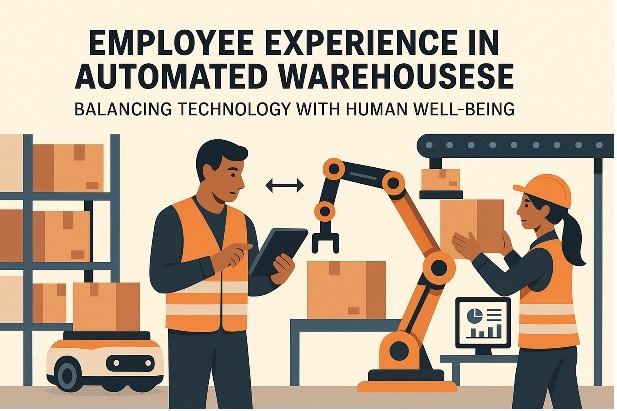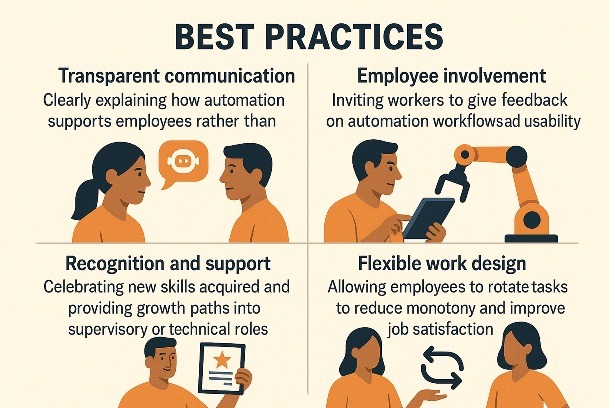
Employee Experience in Automated Warehouses: Technology & Human Well-Being Balancing
Automated warehouses are the present reality for distributors, retailers, and logistics providers. From autonomous mobile robots (AMRs) to AI-driven Warehouse Management Systems (WMS), automation is transforming how goods move, how orders are fulfilled, and how operations scale. While these technologies promise efficiency gains, they also reshape the employee experience. The key challenge lies in balancing automation’s benefits with human elements: ensuring worker well-being, providing reskilling opportunities, and prioritizing safety. In this article, I explore how companies can achieve this equilibrium to create sustainable, human-centered workplaces.
The Human Side of Automated Warehouses
Automation often raises concerns about job loss or displacement. However, most companies find that rather than eliminating human roles, technology shifts them toward higher-value tasks. Workers who once spent hours walking aisles to pick items may now supervise robots, troubleshoot technical issues, or manage inventory through digital dashboards. This shift changes not just job descriptions, but the entire employee experience. Employees must feel secure in their roles, valued by their employer, and confident in their ability to adapt to new tools and technologies. If ignored, fears of obsolescence or unsafe working conditions can erode morale and lead to increased turnover.
Prioritizing Safety: Automation as a Shield Against Hazards
Safety is perhaps the most immediate benefit of warehouse automation. By delegating dangerous tasks to machines, companies can significantly reduce workplace injuries. Automated systems excel at handling repetitive motions that lead to repetitive strain injuries (RSI) and ergonomic issues, such as heavy lifting or awkward postures. But automation introduces new challenges:
Human-robot interaction risks – Workers share space with AMRs, robotic arms, and conveyor systems, requiring clear safety protocols.
Cognitive load – Constant alerts and screen monitoring can lead to mental fatigue if not managed.
Physical design – Automated layouts must still account for ergonomic human tasks, such as manual loading or quality checks.
Employers can address these risks by combining safety training with smart facility design—ensuring designated walkways, visible warning systems, and intuitive interfaces that reduce error.
Reskilling and Upskilling: A Critical Investment
As automation evolves, so must the workforce. The demand for skilled labor rises with technologies like AS/RS, requiring expertise in robotics maintenance, data analysis, and system optimization. Reskilling programs are vital to bridge this gap, transforming entry-level roles into opportunities for growth. Training should go beyond basic robot operation to include:
Digital literacy – Teaching workers to interpret dashboards, use handheld devices, and understand real-time analytics.
Technical troubleshooting – Building problem-solving skills to maintain automated systems.
Cross-functional adaptability – Preparing employees to shift between roles, from warehouse floor operations to customer service or data entry.
Companies that invest in workforce development not only reduce resistance to change but also gain loyal employees who feel well-prepared for the future.
Enhancing Worker Well-Being in Automated Warehouses
The influence of automated warehouses on well-being extends beyond physical safety to encompass mental and emotional health. By automating tedious tasks, workers can shift to higher-value roles, such as supervising systems or problem-solving, which can boost job satisfaction and reduce burnout. One case study demonstrated a 15% increase in productivity alongside a 20% rise in employee satisfaction through the implementation of innovative automation strategies. Yet, challenges remain. In some warehouses, automation can lead to a sense of isolation or monotony if roles become overly supervisory. High turnover rates, sometimes as extreme as 3% weekly, highlight how a “burn-through” model prioritizes output over people. Injury statistics from major players show rates 80% higher than industry norms, often linked to relentless pacing. Well-designed automated warehouses strike a balance between technology and human well-being. Best practices include:

Ultimately, when employees feel safe, skilled, and included, automation becomes a tool for empowerment rather than a source of stress.
Conclusion
The warehouse of tomorrow is not about replacing people with machines. It’s about creating an environment where technology handles repetitive, physically demanding tasks while employees focus on decision-making, oversight, and customer-centric work. Organizations that successfully balance automation with human well-being will not only achieve efficiency gains but also experience higher retention, a stronger culture, and a competitive edge in the battle for logistics talent. LaceUp Solutions offers DSD, Route management, and WMS that can support automated warehouse strategies. Contact us for more information on our solutions.
I hope this article about automated warehouses have been helpful. I will continue to post information related to management, distribution practices and trends, and the economy in general. Our channel has a lot of relevant information. Check out this video about how WMS Helps Train New Employees.


Sorry, the comment form is closed at this time.